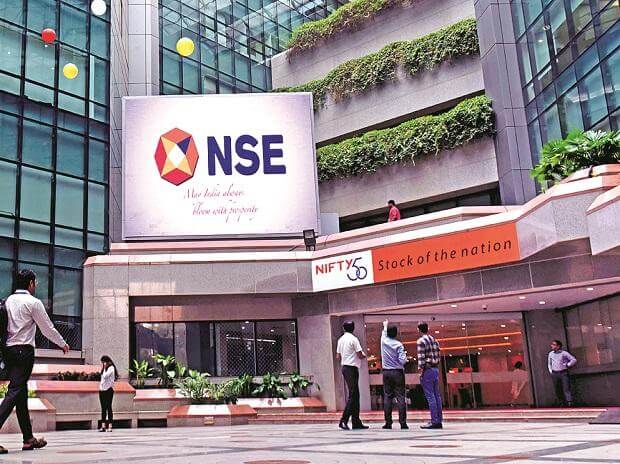This article is written by Anumeha Agrawal, from Symbiosis Law School, Pune. This is an exhaustive article on the National Stock Exchange, its history, structure, mission, achievements, locations and current performance.
Table of Contents
What is the National Stock Exchange
National Stock Exchange (“NSE”) is the leading stock exchange in India and the third-largest stock exchange in terms of the equity shares traded from 2019. NSE and BSE are the only two stock exchanges in India providing country-wise operations. In the year 2017, it had a market capitalization of 2,352 million dollars and was listed as the 10th largest stock exchange.
Purpose and vision
The purpose of establishment of NSE is to improve the financial well being of people.
And it has the vision to continue being a leader, establish its presence throughout the globe and facilitate the financial well being of people.
History and milestones
NSE was established in 1992 on the recommendations of the Pherwani Committee, with the aim to provide access to the market to countrywide investors. The report recognised that there was insufficient liquidity, poor service to small investors and a surge in scams and frauds in the market and mostly a group of brokers traded on BSE, thus there was a need of reform.
However, the committee instead of recommending the establishment of a new stock exchange recommended the integration of existing 19 regional stock exchanges which will be overseen by a computer networked NSE. This not only widened the scope of investment to any person meeting the minimum eligibility criteria but also for the first time established a fully computerised trading mechanism.
NSE has had a 22- year-long presence in India throughout which it had many milestones in its journey, the first being the commencement of its electronic on screening based trading in 1994 which was the first of its kind, followed by the launch of NIFTY 50 Index in 1996 which even now is India’s most trusted investment index. Another milestone in NSE’s development is the commencement of NSE certification for ‘Financial Markets Certification Program’ which was the first step in educating the investors and brokers of what is the requisite level of knowledge required to invest.
After initiating online trading in 2000 NSE launched a platform known as NOW for web-based trading in the year 2008. In the year 2012 NSE also launched a platform-specific to the Small and Medium Enterprises trading. The exchange also entered into an MoU with the London Stock Exchange to enhance their cooperation in 2015. The next year NSE also launched a platform for sovereign gold bond issuances and e-book building platform for the private placement of debt securities.
How does NSE work
NSE functions at a country-wide level with the issuer company, the investors and the intermediaries registered throughout the nation. The criteria for the registration itself is strict to ensure only bonafide participants trade and no fraudulent practice takes place.
The issuers list their securities on ‘National Exchange for Automated Trading’ system and the trade happens on the principle of an order-driven system, i.e. a buyer of securities puts his order on the system and so does a seller of securities, through the system when the prices of both the entities match the trade goes through.
The order matching rules apply in both perfectly matched order and partially matched order, in the former, there is one order in the latter there are multiple trades. The best sell order is at the highest price and the best sell order is at the lowest price. The members put their orders in the system which is displayed to all and continues to be available till the entire size is traded (whether in one trade or by multiple trades). Orders that lay unmatched are the passive orders and the ones that come and match with them as termed as active orders.
There are different markets on NEAT, the Normal Market, The Odd Lot Market, Auction Market.
The normal market is for the trading of regular lot sizes and multiples in dematerialized shares, it has segregated orders like- regular lot orders, special term orders, negotiated trade orders and stop-loss orders. The odd lot market has trading orders smaller than the regular lot size order, in these trades the price and size of the order of the buyer and seller shall match. SEBI only allows trading only on limited physical markets. Auction market has three participants: the initiator, the competitor and the solicitor. The auction is initiated by the Exchange on behalf of the trading members. The trading member can impose three types of conditions on the order placed as per his requirements, namely, conditions related to the time of the trade, conditions related to the price of the trade and conditions related to the quantity of the trade.
The time condition provides the validity period of the trade offer it is of the following types:
- A Day: The trade is only valid for one trading day.
- A Good Till Days/ Date (“GTD”): The trade is valid for the date mentioned or the number of days mentioned, these days are inclusive of the holidays.
- A Good Till Cancelled (“GTC”): This is a perpetual trade till the entire quantity is traded.
- An Immediate or Cancel (“IOC”): The trade can happen only at the time of placing the order and if not the same is removed.
The price conditions can be of the following manner:
- Limit price: The price is provided in the order itself.
- Market Price: The best market price available at the time the order is entered.
- Stop Loss Price: The order enters the market only when the price of the securities falls below the threshold price. This is to prevent any loss to the trading member.
The quantity conditions can also be of the following types:
- Disclosed Quantity (“DQ”): The quantity of the order is only released as the disclosed quantity and when the same is traded then only the disclosed quantity is released again, till the entire order is traded.
For example, the order can be of 100 shares and the DQ can be of 20 shares, so in the market the quantity displayed will be 20 and once that is traded another 20 shares will be displayed as available for trading, the process will go on till all 100 shares are traded.
- Minimum FIll (“MF”): The minimum quantity for which a trade can take place, supposing there are 100 shares for sale and the MF is given as 25 so even if an order is placed for 20 shares for the same price the trade will not happen.
- All Or None (“AON”): These orders are only viable for when the quantity of the buyer and seller match exactly.
Awards & recognition
In the last 28 years NSE has received many awards and recognitions, in 2014 it won CII- Exim Price for Business Excellence, It also received the Indian Exchange of the year by Futures and Options World. Additionally, it also won the Global Finance Award for the Best Derivatives Providers Award 2014. In 2015 it won the Golden Peacock Innovative Product and Service Award, the Asan Banker Achievement Award and FOW Awards for Asia’ Best Technology Product for Market Surveillance.
In 2016 it was again awarded CII Exim Bank Prize for Business Excellence and Global Architecture Excellence Award for the new service initiative.
Subsequently in 2017 NSE won FICCI CSR Award for exemplary innovation and was also ISO Certified.
Facilities provided by NSE
Online trading
Online trading, NSE was the first stock exchange to provide an online trading platform for investors throughout the nation. The flagship index of NSE was initiated in 2016, it is the NIFTY 50 index which provides the average of 50 largest companies listed on the NSE which is used by the investors as an indicator of the performance of Indian capital market worldwide.
Direct market access
The members are also given direct market access facility through Computer to computer link which allows institutional Clients faster access to the markets.
Sovereign Gold bond
Another facility initiated by NSE in 2016 itself was launching a platform for sovereign gold bond issuances.
Risk management
Risk management is a necessary facility provided by the NSE by maintaining requirements of members, like capital adequacy, performance trade record, margin requirement and automatic disablement from trading when requirements are not met with.
Clearing and Settlement
Clearing and Settlement is another facility provided by NSE, it is a legal 3rd party to all transactions happening on the exchange.
Facts & figures
The Investor Protection Fund Corpus on March 31, 2016, was 548 crore, and in June 2020 with a current turnover is 1,38,04,601 crore. The Business Growth in FO Segment from 2000 to 2020 has been spectacular from the turnover 1,01,926 crore to 34,53,91,355 crore.
In the Negotiated Platform, the average trade size increased from 6.64 crores in 1995 to 57.8 crores in 2020.
Location of NSE offices
NSE is a PAN India institution, it has a total of 9 offices. The head corporate office is in Bandra Mumbai and other 8 branch offices are in Mumbai, Ahmedabad, Chennai, Delhi, Hyderabad, Indore, Kanpur and Kolkata.
NSE has the highest number of offices any stock exchange has, these offices increase the accessibility to the investors at the local level. The second highest is five offices of BSE.
Benefits of the NSE
There are several benefits of listing on NSE the foremost is comprehensive visibility i.e listing a company makes it substantially more visible to the investors of all portfolios from equity, derivatives to the commodity market. Not only the listed company is visible to all but also the company is a part of a comprehensive market where it can list all types of its securities as NSE provides a single market for several asset classes.
The scale of operations of NSE is very wide as are the products and services offered by the exchange. The scale of operations of NSE’s products increases the training volumes of the trade for all listed companies as it attracts additional participants and its aid in risk management.
Performance rate of NSE in the current era
The performance rate of any stock exchange is calculated by its index, the index actually represents the measurement of a particular stock listed on the exchange, these stocks are selected in a manner that it covers the majority of the market. From the value of these stocks, the value of the index is derived, thus any change in the price of stock results in the change of the value of the index, as a result, making it an indicator of the market changes.
NIFTY 50 is the principal index of NSE which evidences for the phenomenal growth of the exchange. At the beginning of the financial year of 2000-01, the value of Nifty was 1623.5 and after a decade on 31st March 2010 the value increased to 6521.55 and on 31st March 2020, the value has reached 12105.66. Thus, in the first decade, it gave a return of 301% and in the subsequent decade, the return was 85%.
This return is a clear indication of the exceptional performance of NSE in the capital market and the substantial profits earned by investors and issuers along with overall development of the market itself.
Conclusion
NSE is the leading stock exchange of the country and has been improving its operations continuously, it has played an important role in the capital market development, protection of investors and increased credit availability and general liquidity.
Reference
- https://www1.nseindia.com/products/content/equities/indices/historical_index_data.htm
- https://www.nseindia.com/national-stock-exchange/history-milestones#:~:t e xt =N S E%20was%20incorporated%20in%201992,of%20the%20cash%20market%20segment.
- https://www.nseindia.com/national-stock-exchange/awards-recognition
- https://www1.nseindia.com/corporates/content/listing_benefits.htm
- https://www1.nseindia.com/NSE25Years/index.htm#brand
LawSikho has created a telegram group for exchanging legal knowledge, referrals and various opportunities. You can click on this link and join:
 Serato DJ Crack 2025Serato DJ PRO Crack
Serato DJ Crack 2025Serato DJ PRO Crack











 Allow notifications
Allow notifications



